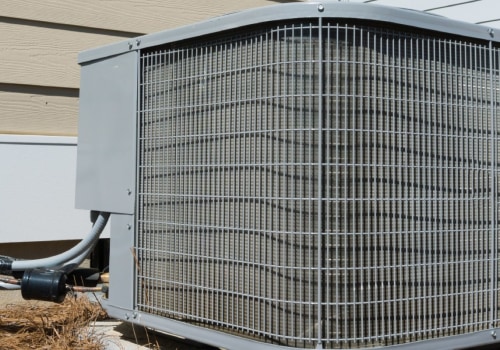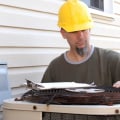Are you dealing with an AC fan repair issue? It can be a daunting task for a homeowner or business to try and troubleshoot the problem. Fortunately, with the right information and help, you can take the steps necessary to get your AC fan working again. This comprehensive overview will help you better understand what's causing the problem and how to go about repairing it. From understanding the basics of how an AC fan works to knowing what tools and techniques to use when diagnosing the issue, this guide will provide you with the knowledge you need to get your air conditioner running again. We'll also look at some of the common issues that can occur with AC fans, as well as provide tips for preventive maintenance.
What is an AC Fan?
An AC fan is a component of an air conditioning system that helps to circulate the cooled air throughout the interior of the building.The fan is typically located within the main AC unit and is designed to draw air in from the outside and expel it inside. The fan works in conjunction with an evaporator coil, which absorbs heat from the air as it passes through, cooling it down to a comfortable temperature. The cooled air is then pushed through the ducts and into the rooms of the building. The AC fan operates by spinning at high speed, drawing in air from outside.
As the air passes through the evaporator coil, it is cooled and then expelled into the building. This process helps to maintain a consistent temperature throughout the interior, ensuring that everyone remains comfortable and content.
AC fan
, air conditioning, evaporator coilRepair Solutions for Malfunctioning Fans
When it comes to repairing an AC fan, there are several different solutions available. The most common repair option is to replace the fan motor or the entire fan assembly.If the fan is still functioning, but is making unusual noises, then it may be necessary to lubricate the fan blades. In some cases, simply cleaning the fan blades can restore the fan’s efficiency. Depending on the severity of the issue, more complex repairs may be necessary, such as replacing a defective capacitor or replacing worn-out bearings. If the fan cannot be repaired, then it may be necessary to install a new fan.
This should be done by a qualified technician who is familiar with the type of fan you have. Installing a new fan will require a thorough understanding of the wiring and power requirements for your particular model of air conditioner. It’s also important to ensure that the new fan is compatible with your existing system. In some cases, it may be beneficial to upgrade your AC unit to a more efficient model. Newer air conditioners are designed with energy efficiency in mind and can save you money on your energy bills.
If you decide to upgrade your AC unit, make sure that the new unit has a compatible fan.
Types of AC Fans
When it comes to AC fan repair, it's important to understand the different types of fans used in air conditioning units. Generally, there are two main types of fans used in AC units: axial and centrifugal.Axial Fans
Axial fans are characterized by their fan blades which are arranged parallel to the shaft that drives the fan. These fans use a propeller-like design to move air in a linear direction, with the fan blades resembling a large screw. Axial fans are typically more efficient than centrifugal fans and can be used in a variety of applications, including cooling electronics and exhausting hot air from a room.Centrifugal Fans
Centrifugal fans are designed with curved blades that rotate around a central hub.As the fan blades spin, they generate a pressure differential between the front and back of the fan, causing air to be drawn into the fan inlet and then expelled through an outlet. Centrifugal fans are used for larger applications, such as commercial HVAC systems and industrial cooling systems. When it comes to AC fan repair, it's important to understand which type of fan is used in your unit and how it works. This will help you diagnose any potential issues with your AC fan quickly and accurately.
Replacing an AC Fan
Replacing an AC fan can be a tricky process, and should only be undertaken by experienced technicians or those with the necessary experience and knowledge. Before attempting to replace the fan, it's important to ensure that the power supply is turned off and that all wiring is disconnected from the unit.Additionally, it's essential to check the manufacturer's instructions for specific details on how to replace the fan. The first step in replacing an AC fan is to remove the old fan. This can be done by unscrewing the screws that hold the fan in place and then carefully sliding it out. Make sure to keep all screws and hardware together in a safe place. Next, take out the new fan, making sure to match up the size and shape to the old one.
Connect the wiring to the new fan and make sure it is securely attached. Once the new fan is installed, it's important to test it before powering up the unit. If everything looks good, then turn on the power and check that the fan is working correctly. If there are any issues, then turn off the power immediately and double-check all wiring connections. Finally, make sure to double-check all screws and hardware, ensuring that they are securely fastened in place. Once everything is in its proper place, then you can turn on the power supply and enjoy a cool, comfortable environment once again.
Troubleshooting Tips and Advice
When it comes to troubleshooting AC fans, there are a few basic steps you can take to diagnose and correct any issues.Firstly, check the fan’s power source to make sure it is receiving the correct amount of electricity. If the fan is not receiving enough power, it can cause it to malfunction. Secondly, make sure all components of the fan are secure and properly connected. Loose connections can cause the fan to vibrate, making it less efficient.
Thirdly, check the fan blades for any signs of wear and tear. If the blades are damaged, they may need replacing. Another way to troubleshoot AC fans is to listen for any strange noises or vibrations. If you hear any unusual sounds, it could be an indication that something is wrong with the fan motor. Lastly, if you are still unable to diagnose the issue, it is best to consult with a professional for further assistance.
Preventive Maintenance
In order to keep your AC fan running smoothly, it is important to carry out regular maintenance checks.Firstly, make sure that all of the components are clean and free from dust and debris. This will help keep the fan running efficiently and will reduce the chances of it over-heating or breaking down. Secondly, check that all of the electrical connections are secure and properly connected. Lastly, inspect the fan blades for any signs of damage or wear and tear, and replace them if necessary.
Inspecting an AC Fan for Problems
When inspecting an AC fan for potential problems, it's important to start by checking the power source.Make sure the fan is plugged into a working outlet and that the circuit breaker is not tripped. If the power source is good, then you can move on to check the fan blades. Look for any signs of wear and tear, such as bent or broken blades. You should also check the fan belt for any signs of wear or cracking.
If any of these issues are present, then it's likely that the fan needs to be replaced. Next, you'll want to inspect the fan motor. Make sure that all of the wires and connections are secure and that nothing has been disconnected. Check the motor for signs of overheating, such as discoloration or scorching. If there are any issues with the motor, then it's likely that it will need to be replaced or repaired. Finally, you'll want to check the fan controls.
Make sure that all switches and knobs are functioning properly and that they aren't causing any unexpected problems. If everything looks okay, then you can move on to testing the fan itself. Turn it on and off several times to make sure that it's running properly and that there aren't any unexpected issues. By following these steps, you can quickly identify any potential problems with your AC fan. If you find any issues, then it's important to contact a professional repair service to have them fixed as soon as possible.
Signs that You Need to Repair an AC Fan
AC fan repair can be a tricky business, so it’s important to be aware of the signs that indicate something is wrong with your unit.Here are some common indicators that your AC fan needs to be repaired:1.Unusual Noises – If you hear a strange grinding or squealing noise coming from your AC unit, this could indicate a problem with the fan. This could be due to a damaged bearing, or simply a build-up of dust or dirt.2.Unusual Smells – If your AC fan is not functioning properly, it may produce an unpleasant smell. This could be caused by a burnt-out motor or wiring issue.3.Poor Airflow – If you notice that your air conditioner is not producing enough cold air, this could be a sign of an issue with the fan motor. This could be due to a lack of power or a broken fan blade.4.Uneven Cooling – If some parts of your home or office are cooler than others, this could be due to an AC fan that is not working properly.
This could be caused by an obstruction in the fan, or an electrical fault. If you notice any of these signs, it’s important to get the unit checked and repaired as soon as possible. Ignoring these issues can lead to more serious problems and higher repair costs in the future.
Common Causes of Malfunctioning Fans
Dirt and Dust: Dirt and dust can easily accumulate in the fan's motor, blades, or other components, reducing its efficiency and leading to malfunction. This is especially common in older units that haven't been cleaned for a long time.Faulty Motor:
The fan motor is responsible for providing power to the fan, so if it malfunctions, the fan won't be able to run.This is often caused by a faulty capacitor, broken wires, or other electrical issues.
Excessive Heat:
The fan may overheat due to an inadequate cooling system or a lack of airflow. This can cause the fan to shut down or malfunction.Damaged Blades:
The fan blades can become damaged due to excessive wear and tear, or if they come into contact with foreign objects.This can cause the fan to make strange noises, or even stop working altogether.
Misaligned Parts:
If any of the fan's components become misaligned, it can cause the fan to vibrate excessively or make strange noises. This is often caused by worn-out bearings or a loose mounting bracket.Faulty Wiring:
Faulty wiring can prevent the fan from receiving the correct amount of power, causing it to malfunction.This is often due to worn-out wiring or incorrect connections.











